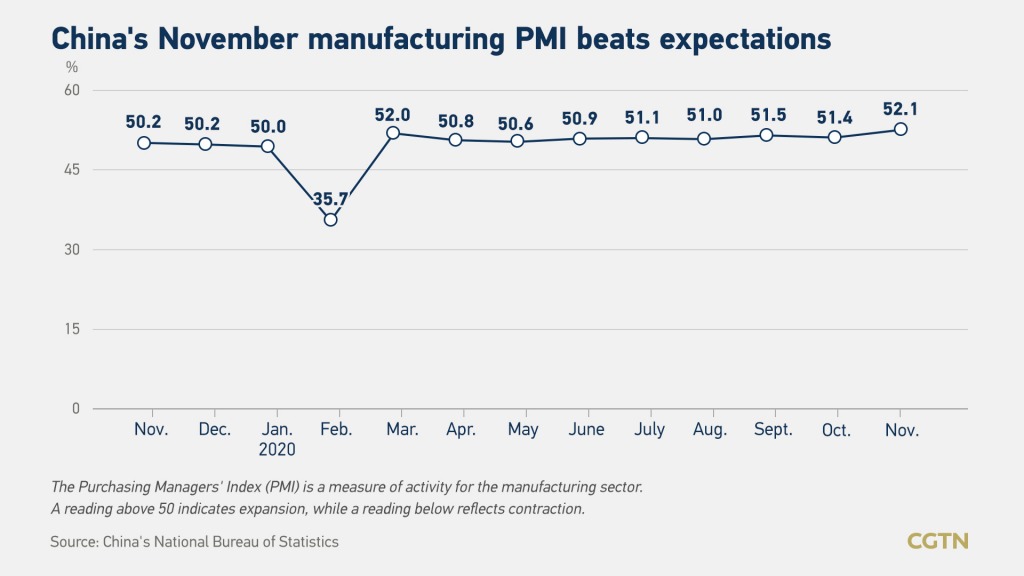The purchasing managers’ index (PMI) for China’s manufacturing sector came in at 52.1 in November, up from 51.4 in October, the National Bureau of Statistics (NBS) said Monday.
The figure marked the ninth consecutive month above the benchmark of 50, which indicates an expansion in activity on a monthly basis, and beat the 51.5 median forecast of 22 economists polled earlier by Reuters.

As a result of bolstering prevention works against the COVID-19 pandemic, China’s economy continues to steadily pick up, said Zhao Qinghe, senior statistician at the NBS, adding that “among the 21 industries surveyed, the number of sectors holding PMI in the expansion range increased to 19, and the manufacturing outlook is booming.”
“PMI has continued to beat market expectations, suggesting strong momentum in China’s economic recovery,” Wang Dan, chief economist at Hang Seng Bank (China), told CGTN.
In a breakdown, both supply and demand contributed to the figure’s rise.
“The improvement was broadly based but led mainly by production and new orders of sub-indices,” said Lu Ting, chief China economist at Nomura.
The production index and the new order index were 54.7 and 53.9 in November, increasing by 0.8 and 1.1 percentage points on a monthly basis, reaching high points for the year, according to Zhao.
Imports and exports also picked up steadily. The new export order index and import index were 51.5 and 50.9, increasing by 0.5 and 0.1 percentage points respectively compared to last month, Zhao added.
“Foreign new orders improved despite the recurring coronavirus, driven by holiday demand and the reopening of businesses and schools in the U.S. and Europe,” noted Wang.
The rise in new export order index suggested “strong demand for Chinese products from overseas economies as they remain mired in the pandemic,” Lu also said.
However, an extended pandemic outside of China may eventually dampen demand for China’s exports if the purchasing power in overseas economies diminishes and they adjust their manufacturing production to the new normal, Lu added.
The price index rose sharply. With the recent general rise in commodity prices and the acceleration of production and procurement activities by enterprises, the purchasing prices of raw materials and product sales in the manufacturing industry increased significantly this month. The purchase price index and ex-factory price index of major raw materials were 62.6 and 56.5, 3.8 and 3.3 percentage points higher than last month, respectively.
Enterprises in different scales keep recovering. The PMI of large, medium and small enterprises were 53.0, 52.0 and 50.1, increasing 0.4, 1.4 and 0.7 percentage points on a month-on-month basis, respectively.
“Small firms remain under stress as their unemployment kept shrinking. The rebound of consumption is too weak to sustain a broad recovery in [the] private sector. With the economy gathering steam in the coming months, demand for liquidity will increase, especially from small firms,” Wang told CGTN.
However, despite the above positive changes, the manufacturing industry’s recovery has been uneven. The PMI of the textile and apparel industry has been below the benchmark, and the industry’s outlook is still weak, said Zhao.
The official non-manufacturing PMI rose further to 56.4 in November from 56.2 in October, mainly led by a rise in the sub-index for the construction sector, which was bolstered by the stimulus introduced earlier this year, although funds and projects might only have become available in the past couple of months, noted Lu.
Service activities were up significantly, particularly in construction, transportation, finance and IT services. Yet the housing market remained tame as markets expected the restrictive policies to stay in place, according to Wang.
“We expect China’s official manufacturing PMI to remain solid at around 51-52 in the coming months, while the official non-manufacturing PMI may slide a bit on a high base,” said Lu.
Wang predicted that the monetary policy would remain accommodative to support the recovery.
Jackson Wong, asset management director of Amber Hill Capital, told CNBC that China’s data front has been embodying a “steady and stable recovery”.
Wong said the world’s second largest economy is tipped to stay on the growth trajectory into next year, and could be “the only major economy to register growth this year”.
China’s economy is expected to expand by around 2 percent for the full year. Although this would be its weakest growth rate in over three decades, it would still be much stronger than other major economies that continue to battle COVID-19: China is actually projected to be the only country to see positive growth this year.
Julian Evans-Pritchard, a senior China economist at consultancy Capital Economics, said in an interview with CNBC that household spending forms the most “significant development” in China nowadays, which may continue to allow for a tightening labor market and recovering consumer sentiment.
“That should further support the rebound in services activity. It should also boost manufacturing, which will continue to benefit too from supportive fiscal policy and strong foreign demand,” he wrote in a note after the PMI data release.




